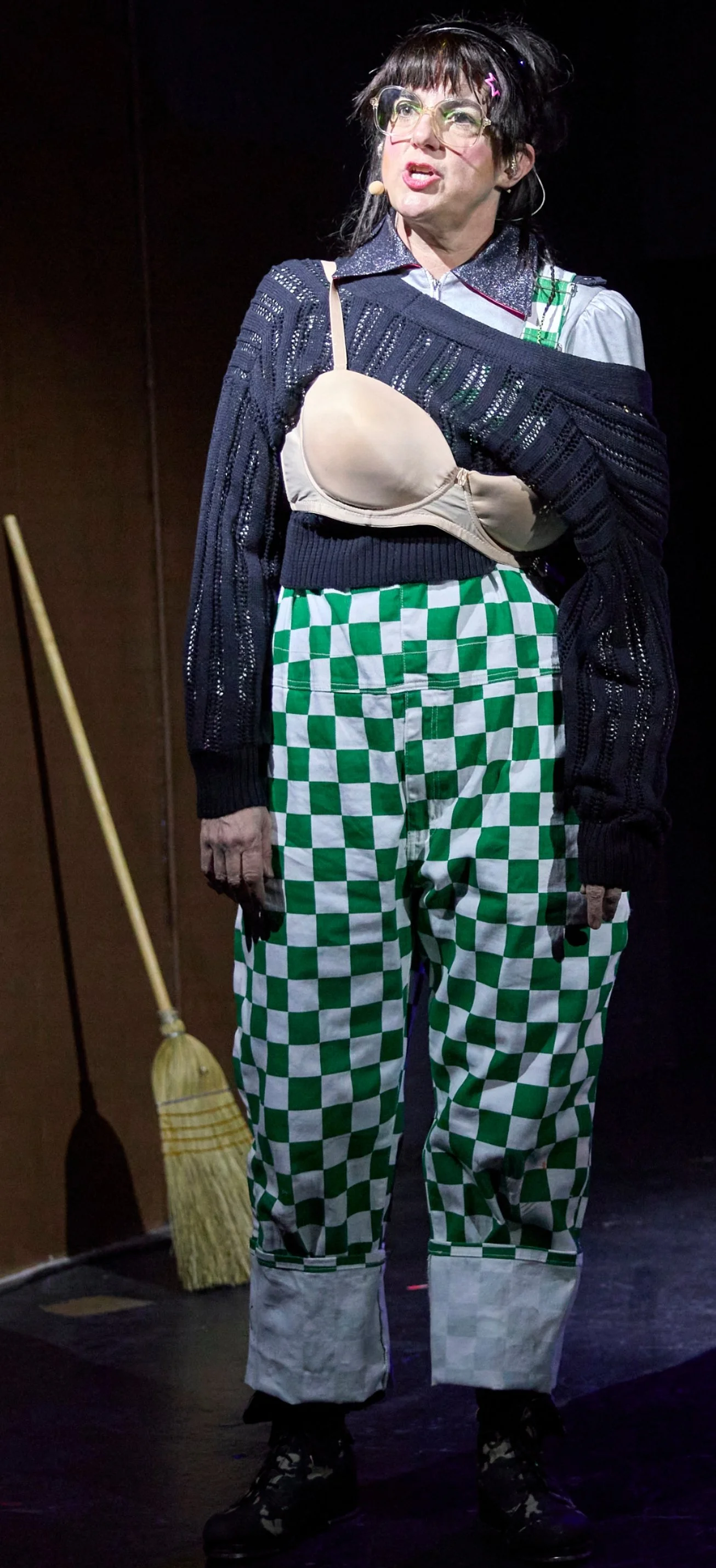Queer icon and classically trained electric violinist Bitch stars in B*tchcraft, directed by Margie Zohn.
Of all the productions opening Off-Broadway this season, B*tchcraft may well be the most bewitching. With music and lyrics written by Bitch, and book by her and Margie Zohn, who also directs, it’s a wild journey into how Bitch, a quiet girl from suburban Michigan, shed her chrysalis to become the queer icon that she is today.
Bitch, as herself, in her new musical play B*tchcraft.
Born Karen Mould, this veteran feminist and classically trained violinist, who was half of the 1990s queer duo Bitch and Animal, is now a performer who marches to her own drum. In this autobiographical memoir, Bitch packs her whole life, warts and all, into a 90-minute yarn.
The surreal Prologue requires a suspension of one’s disbelief, and then some: On a nearly dark stage, an old woman named The Crone (Cary Curran) materializes, writes in a giant notebook, tears out the page, and lets the pieces float behind a wooden pentagon-shaped cauldron as she makes a stirring motion. Her actions awaken Little Bitch, who sings the theme from “Fallen Witch 1” inside the cauldron. The lid then pops open, revealing Little Bitch with her stuffed animal, Beaver. The Crone exits, as a magical broom drops from the flies.
Bitch looks at the patriarchy and more in her autobiographical memoir B*tchcraft.
This strange beginning only gets stranger. Little Bitch hears her father’s voice calling her name. She ignores him until she can’t. “Karen, clean up this mess!” A magical broom whooshes beside her. But as she reaches for it, it clatters to the floor—and she goes down with it. The broom is now like any other broom. But Little Bitch grabs it and runs into her house.
The theme of patriarchy is established from the get-go. Although it first manifests itself in the voice of Bitch’s father, it will be re-embodied again in other males who enter the story. And the broom has symbolic meaning in B*itchcraft. Depending on the dramatic moment, it can represent either freedom or oppression for Bitch.
Brian Pacelli’s video projections are terrific! They allow one to see the family’s home like the cross-section of a doll’s house: the middle floor is Dad’s living room; the basement is Mom’s tap school; and upstairs is Little Bitch’s room.
The video projection zooms in on Dad’s Floor, where one glimpses the back of a wingback chair and TV, along with a title in kid’s handwriting: “Beer and Bad News.” Little Bitch shares with the audience that she has the job of pouring her father the perfect beer. But she trips one day as she tiptoes through the living room, eliciting a tyrannical snarl from her father: “What’s that bloomin’ racket?” Terrified, Little Bitch starts sweeping with her broom, and establishing a rhythm, launches into her first song aptly called “Quiet Child.”
Longstanding queer music icon Bitch marches to her own drum in B*tchcraft at Wild Project. Photographs by Eric McNatt.
My dad’s English
We were the weird English family
In early ’80s suburban Michigan
As a kid he ran to the bomb shelter
World War II England.
Little Bitch explains that her father aspired to be a painter. But, as an only child, he was destined to take care of his parents, not to mention the three daughters who came along after he married Bitch’s mother, who had dreams of being a musical theater star on Broadway. But Michigan is a long way from Broadway—and her mother had three children to raise.
One of the best scenes in the show is when Little Bitch hears a violin on a Sesame Street episode. She is so enchanted by its sound that she persuades her parents to get her a violin. And they do. In celebration, Little Bitch sings the song “Little Star.”
This’ll be my cape
This’ll make me fly
Riding this melody.
The show alternates between Bitch’s narration and the performances of the songs. In whirlwind fashion, the audience sees Little Bitch mature into Teenage Bitch and then College Bitch. As Teenage Bitch, she has her first period, which is dramatized as a kind of earthquake in her girlish world. As College Bitch, she meets Danny, a lesbian boy-girl, in acting school at DePaul University. Danny, in fact, suggests that they start a band called Bitch and Animal, with Karen adopting the name Bitch, and she Animal. Sexually outspoken and socially confrontational, Animal is quite a trailblazer. Indeed, Bitch has met her match, and the two go on tour.
Suffice it to say, Bitch and Animal make a name for themselves, even though they make mistakes along the way—and their band eventually dissolves. Still, Bitch is a survivor, and proves in the play’s closing scenes that like the phoenix, she rises from her ashes.
B*tchcraft is not for sensitive souls. But it is perfect for theatergoers who want to see the queer icon Bitch back in top form.
B*tchcraft: A Musical Play runs at Wild Project (195 E. 3rd. St.) through March 1. Evening performances are at 7 p.m. Thursday through Monday. For tickets and more information, visit thewildproject.org.
Book: Bitch & Margie Zohn
Music & Lyrics: Bitch
Direction: Margie Zohn
Additional Music & Lyrics: Faith Soloway, Bitch and Animal, Melissa York, Jon Hyman, and Greg Prestopino
Scenic Design: Samantha Tutasi
Costume Design: Andrea Lauer
Lighting Design: Amina Alexander
Sound Design: Sean Hagerty
Projection Design: Brian Pacelli
Choreographer: Michelle Dorrance






